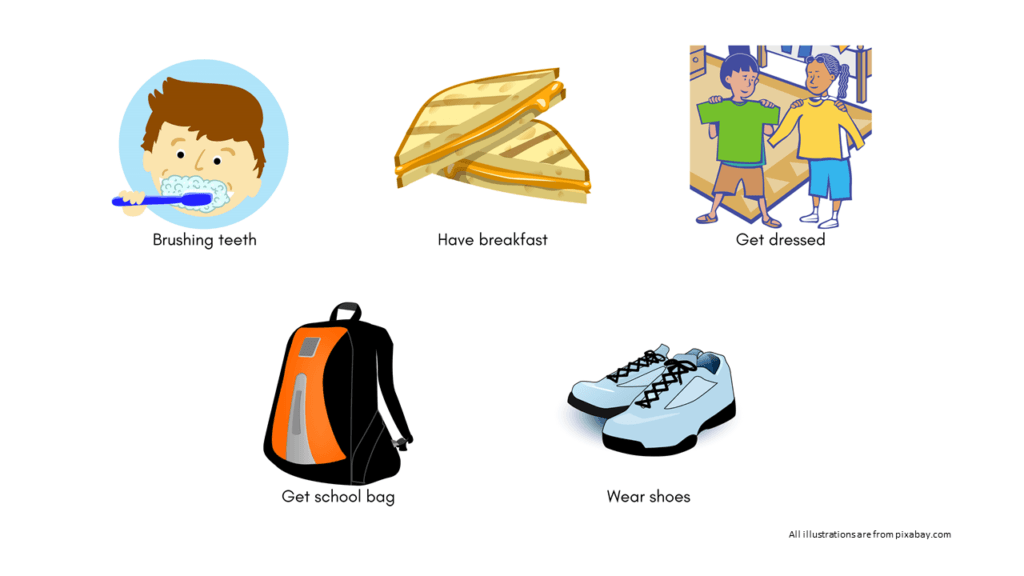
Routine is a series of actions you do regularly. From the moment you wake up in the morning, do you reach out for your phone to turning on your favorite music while you go about getting ready for your day. You may have a different routine for weekdays and weekends. You may have a different routine during school / public holidays.
Importance of Routine
Body Clock
Routine in-built in us provide our body to work accordingly. For example, certain time of the day when you would go for bowel movement or specific actions that you will perform before bedtime. Having a routine also supports your child. Once the routine is established, they would know what is to come – shower, brushing teeth, bedtime stories, lights off and sleep. It prepares their body to get into sleep mode. Therefore, even if you change location (e.g. traveling), having a bedtime routine helps your child to settle into the new environment.
Setting Expectations
Having a routine sets an expectation on what is to happen next. For example, what needs to be done to get ready for school in the morning or after school before play time (e.g. complete homework). Instead of struggling to remind and nag constantly, routine provides a clear set of expectations for you and your child to achieve.
Confidence
Having a routine means your child has learned certain skills to complete his tasks – brushing teeth, taking shower or clean up after dinner. It builds their confidence where they can be independent and competent in completing tasks without help. They understand what is expected of them as well as having the ability to perform the task.
Stability
Having a routine gives your child stability in environment and emotional support. It provides an expected outcome. You would expect water to come out from your water tap when you turn it on. When it doesn’t, it stresses you out with no water, finding a plumber, etc. A routine for your child provides a similar experience for your child.
Challenges in creating a routine
It is important to understand that routine is not created overnight. There are bound to be challenges as your child may not have learned the necessary skill or may have a different routine established within them. Thus, in order to create a successful routine you will need consistency and persistence. The common challenges that we have come across are:
Time
You child needs time to learn the skill. Therefore, you need to teach the skill first. For example, you are trying to establish a schoolday morning routine such as
Brush teeth >> Have breakfast >> Get dressed >> Get school bag >> Wear shoes
Before you expect your child to “automatically” complete the routine, you will need to ensure that your child is competent in each skill required to complete the routine. If you child is just learning how to brush his teeth, you would need to allocate more time for him to complete his brushing. Same goes with each skill. As you work backwards, you may realize that you need longer time to get your child ready for school. Adjust your time accordingly and allow your child to complete their routine at their pace.
Transition
You child may have difficulty to transition from one activity to the next. You can support your child to transition by providing advance notice, use of timer or a visual support. This will establish expectation clearly with your child. For instance, you expect to leave the playground at 6:00pm. You may start with giving notice to your child that they have 15 minutes left at 5:45pm. Then, another reminder at 5:55pm that they have 5 minutes left. And, at 6:00pm, you can inform your child that it is time to go. For the initial transition, your child may protest or ask for extra time. You may want to allow for 2 more minutes and communicate that clearly with your child. Then, leave the playground the moment the extra time is up. You child may protest, however, it is essential that you hold your ground so that you do not reward his “protest” by allowing more time.
Lost Focus
You child may have trouble to complete the routine for they were distracted or may even forget what they were supposed to do. Here, you will need tools and strategies to help them to refocus back to the task and complete on time. You may start the routine with one task. After your child has master the task, you increase another. You add another once your child has master both tasks. Often times, you may need to provide a break in between the task where your child is allowed to choose their favorite activity before continue to complete the remaining tasks. Other tools that may support your child is visual support or checklist. Each will help your child to re-focus on the routine.
Conclusion
Having a routine at home provides stability in your life. You child has clear expectation of what you would like them to accomplish on a daily basis and you can focus on supporting them to acquire skills to maintain the routine. You child can master the skills needed and thus giving them confidence and independent skills. Reward them with their choice of favorite activities or a treat.
